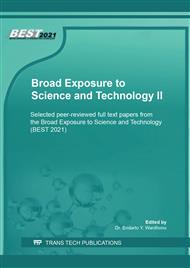[1]
Gibson R. 1994 Principles of Composite Material Mechanics, New York: McGraw-Hill Inc, p.27.
Google Scholar
[2]
Pramono A, Jamil A M and Milandia A. 2018 Aluminum-based Composites by Severe Plastic Deformation Process as New Methods of Manufacturing Technology. In: MATEC Web of Conferences, paper no. 04011, pp.1-9.
DOI: 10.1051/matecconf/201821804011
Google Scholar
[3]
Daniel G. 2015 Composites Materials and Design and Applications. 3rd ed. Boca Raton, Florida: CRC Press. Taylor & Francis Group, p.3.
Google Scholar
[4]
Ning H. 2012 Composites and Their Applications. InTech: Horoschenkoff A and Christner C (eds) Tech Prepress design team, Janeza Trdine, Rijeka, Croatia, pp.355-397.
Google Scholar
[5]
Kamal K. 2017 Composite materials Processing Applications Characterization. Advanced Nano-engineering Materials Laboratory. Indian Institute of Technology Kanpur, pp.369-411.
Google Scholar
[6]
Pramono A. 2016 Investigation of Severe Plastic Deformation Processes for Aluminum Based Composites. Ph.D Thesis, Tallinn University of Technology, Tallinn-Estonia.
Google Scholar
[7]
Pramono A, Zulaida YM, Suryana A, Sandi TA, and Fawaid M. 2018 Effect of Rolling Cycles and Setting Direction of The Reinforcement on Aluminum Based Composite by RPRF Methods. Vanos Journal of Mechanical Eng Education. 3 (2) 129-138.
Google Scholar
[8]
Saito Y, Utsunomiya H and Tsuji N. 1999 Novel ultra-high straining process for bulk material development of the accumulative roll bonding (ARB) process. Acta Mater. 47 579–583.
DOI: 10.1016/s1359-6454(98)00365-6
Google Scholar
[9]
Argentero S. 2012 Accumulative roll bonding (ARB) technology of aluminum alloys. In: Proceedings of Strategic Management Factors of MNC's Subsidiaries–Comparative Analysis of Metal Manufacturing and Other Industries, Praque, Czech Republic, (Klapalova, A., eds). p.1–6.
Google Scholar
[10]
Amirkhanluo S, Askarian M and Ketabchi M. 2015 Gradual formation of nano/ultrafine structure under accumulative press bonding (APB) process. Materials Characterization. 109 57-65.
DOI: 10.1016/j.matchar.2015.09.017
Google Scholar
[11]
Pramono A. Merging method of aluminum fiber composite materials with alternating pressure and rolling process using repetitive press roll forming (RPRF). Patent Application: 001/P/HKI/2000-P00201709889. University of Sultan Ageng Tirtayasa Banten, Indonesia (2017).
Google Scholar
[12]
Pramono A, Kollo L and Veinthal R. 2015 Aluminum based composite by novel process: repetitive press roll bonding (RPRB), Procedia Chemistry. 16 473-479.
DOI: 10.1016/j.proche.2015.12.081
Google Scholar
[13]
Pramono A, Dhoska K, Markja I and Kommel L. 2019 Impact pressure on mechanical properties of aluminium-based composite by ECAP-parallel channel, Pollack Periodica. 16 (1) 67-74.
DOI: 10.1556/606.2019.14.1.7
Google Scholar
[14]
Pramono A, Sulaiman F, Alfirano, Alhamidi A A and Milandia A. 2020 Fabrication of the Ti/SiC Based Composites by Self-Propagating High Temperature Synthesis. International Journal of Innovative Technology and Interdisciplinary Sciences, 3 (4) 513–520.
DOI: 10.20944/preprints202008.0596.v1
Google Scholar
[15]
Pramono A, Dhoska K, Alhamidi A, Trenggono A and Milandia A. 2019 Investigation of mechanical properties on composite materials by several of severe plastic deformation (SPD) methods, IOP Conference Series: Materials Science and Engineering. 673 (1) 012120.
DOI: 10.1088/1757-899x/673/1/012120
Google Scholar
[16]
Valiev R Z and Langdon T G. 2006 Principles of equal-channel angular pressing as a processing tool for grain refinement. Progress in Materials Science. 51 (7) 881-981.
DOI: 10.1016/j.pmatsci.2006.02.003
Google Scholar
[17]
Amirkhanlou S, Ketabchi M and Parvin N. 2013 Accumulative press bonding; a novel manufacturing process of nanostructured metal matrix composites. Materials and Design. 51 367–374.
DOI: 10.1016/j.matdes.2013.04.032
Google Scholar
[18]
Amirkhanlou S, Ketabchi M and Parvin N. 2015 Achieving ultrafine grained and homogeneous AA1050/ZnO nano composite with well-developed high angle grain boundaries through accumulative press bonding. Materials Science & Engineering A. 627 374–380.
DOI: 10.1016/j.msea.2015.01.025
Google Scholar
[19]
Pramono A, Kollo L, Kallip K, Veinthal R and Gommon J K. 2013 Heat treatment of ultrafine grained high-strength aluminum alloy. Key Engineering Materials. 604 273‒276.
DOI: 10.4028/www.scientific.net/kem.604.273
Google Scholar
[20]
Pramono A, Dhoska K, Moezzi R and Milandia A. 2021 Ti/SiC based metal matrix composites by using self-propagating high temperatures synthesis (SHS). Revue des Composites et des Matériaux Avancés-Journal of Composite and Advanced Materials, 31 (3) 125-129.
DOI: 10.18280/rcma.310302
Google Scholar
[21]
Pramono A, Zulfia A, Alhamidi A, Alfirano A, Suryana S and Milandia A. 2021 Characteristics of aluminum-based composites reinforced with Al2O3/B4C as a result of accumulative roll bonding. TEKNIKA-Journal of Science and Engineering, 17 (02) 7-12.
DOI: 10.36055/tjst.v17i2.12156
Google Scholar
[22]
Pramono A, Kollo L, and Veinthal R. 2016 Hot and cold regions during accumulative roll bonding of Al/Al2O3 nanofibre composites. Proceedings of the Estonian Academy of Sciences, 65 (2) 132–137.
DOI: 10.3176/proc.2016.2.12
Google Scholar


